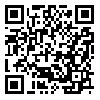Volume 6, Issue 2 (8-2019)
NBR 2019, 6(2): 254-260 |
Back to browse issues page
Download citation:
BibTeX | RIS | EndNote | Medlars | ProCite | Reference Manager | RefWorks
Send citation to:



BibTeX | RIS | EndNote | Medlars | ProCite | Reference Manager | RefWorks
Send citation to:
Salari Z, Malekloo M. The study of antimicrobial effects of ethanolic, methanolic and aqueous extracts of six species of Fessia (Asparagaceae) on some pathogenic bacteria and Candida albicans. NBR 2019; 6 (2) :254-260
URL: http://nbr.khu.ac.ir/article-1-2758-en.html
URL: http://nbr.khu.ac.ir/article-1-2758-en.html
azad kerman , Salari@iaubaft.ac.ir
Abstract: (7339 Views)
In this research, the antimicrobial effects of ethanolic, methanolic and aqueous extracts obtained from aerial parts, leaves and bulbs of six species of Fessia were investigated on the growth of some of micro-organisms, including Staphyloccocus aureus, Bacillus anthracis, Kelebsiella pneumonia and Candida albicans. Plant samples were collected from natural habitats and were then identified. The evaluation diameter of inhibitory zone, well and MIC (minimum inhibitory concentration) methods were used for the assessment. Aqueous and methanolic extracts obtained from the leaves and bulbs did not affect any of the studied micro-organisms. The results showed that ethanolic extract of the species Fessia khorassanica, had stronger inhibitory effect on the Candida albicans in comparison with the control group.
Type of Study: Original Article |
Subject:
Plant Biology
Received: 2017/02/16 | Revised: 2019/09/24 | Accepted: 2018/11/11 | Published: 2019/07/30 | ePublished: 2019/07/30
Received: 2017/02/16 | Revised: 2019/09/24 | Accepted: 2018/11/11 | Published: 2019/07/30 | ePublished: 2019/07/30
References
1. Ashrafi, F. 2011. Practical microbiology together with biochemical function. - Ahsan Press, Tehran. pp: 51-68, 190-199.
2. Amoozegar, M.A. 2003. Microbiology. - Pooran Pajoohesh Press, Tehran.
3. Bangani, V., Crouch, N.R. and Mulholland, D.A. 1999. Homoisoflavanones and stilbenoids from Scilla nervosa. - Phytochemistry 51: 947-951. [DOI:10.1016/S0031-9422(99)00155-7]
4. Crouch, N.R., Bangani, V. and Mulholland, D.A. 1999. Homoisoflavanonesfrom three South African: Scilla species. - Photochemistry 51: 943-946. [DOI:10.1016/S0031-9422(99)00154-5]
5. Hafez Ghoran, S., Mighani, H. and Ebrahimi, P. 2014. In-vitro antibacterial activity of chloroform, ethylacetate and hydroalcohlic extracts of Scilla persica Hausskn. - J. Gorgan Univ. Medic. Sci. 16: 106-113.
6. Harsh, M.L. and Nag, T.N. 1984. Antimicrobial principal From in vitro tissue culture of Peganum harmala. - J. Nat. Prod. 47: 365-367. [DOI:10.1021/np50032a022]
7. Karen, d., Audrey, K. and Johannes, B. 2011. Anti- inflammatory and antimicrobial profiles of Scilla nervosa (Burch) Jessop (Htyacinthaceae). - S. Afr. J. Sci. 107: 5-6. [DOI:10.4102/sajs.v107i5/6.259]
8. Kakeagawa, H., Matsumoto, H. and Satoh, S. 1988. - Planatamed. 54: 385-389. [DOI:10.1055/s-2006-962477]
9. Kayıran, S.D. and Özkan, E.E. 2017. The ethnobotanical uses of Hyacinthaceae species growing in Turkey and a review of pharmacological activities. - Indian J. Tradit. Know. 16: 243-250.
10. Lee, D., Choobk, Y., Cheon, M., Lee, H., Lee, A. and Kim, H. 2009. Anti-inflammatory effects of Asparagus cochinchinesis extract in actute and chronic cutaneous inflammation. - J. Ethonopharmocol. 121: 28-3. [DOI:10.1016/j.jep.2008.07.006]
11. Malekloo, M., Nejadsattari, T., Hamdi, S.M. and Mehregan, I. 2014. Fessia assadii (Asparagaceae), a new species from Iran. - JBES 5: 78-85.
12. Mario, M., Manuel, B., Crespo, A., Juan, I. and Fay, M.F. 2011. Molecular phylogenetics of subfamily fornithogaloideae (Hyacinthaceae) based on nuclear and plastid DNA regions, including a new taxonomic arrangement. - Ann. Bot. 107: 1-37. [DOI:10.1093/aob/mcq207]
13. Martínez-Azorín, M., Crespo, A., Manuel, B., Juan, I. and Fay, M.F. 2011. - Ann. Bot. 107: 1-3. [DOI:10.1093/aob/mcq207]
14. Mordak, E. V. 1984. Scilla L. - In: Davis, PH. (ed.), Flora of Turkey and the East Aegean Islands, 8: 214-223. - Edinburgh University Press, Edinburgh.
15. Pfosser, M. and Speta, F. 1999. Phylogenetics of Hyacinthaceae based on Plastid DNA Sequences. - Ann. Missouri Bot . Gard. 86: 852-875. [DOI:10.2307/2666172]
16. Speta, F. 1998a. Hyacinthaceae. - In: Kubitzki, K. (ed.), The families and genera of vascular plants. - Springer, Berlin. pp: 261-285. [DOI:10.1007/978-3-662-03533-7_35]
17. Speta, F. 1998b. Systematic analysis of the genus L. s. l. (Hyacinthaceae). - Phyton 38: 1- 141.
18. Sparg, S.G., Van Staden, J.S. and Jager, A.K. 2002. pharmacological and phytochemical screening of two Hyacinthaceae species: Scilla natalensis and Ledeboria ovatifolia. - J. Ethnopharmacol. 80: 95-101. [DOI:10.1016/S0378-8741(02)00007-7]
19. Wendelbo, P. 1972. Scilla L. - In: Rechinger, K.H. (ed.), Flora Iranica. vol. 155: 107-119. - Akad. Druck- und Verlagsanstalt, Graz.
20. Yamaguchi, T. 1959. The journey of the Lycoris radiate herb to Japanas a relief plant in a rice lean year. - Nat. Sci. Mus. Tokyo. 26: 147-153.
Send email to the article author
| Rights and permissions | |
 |
This work is licensed under a Creative Commons Attribution-NonCommercial 4.0 International License. |







